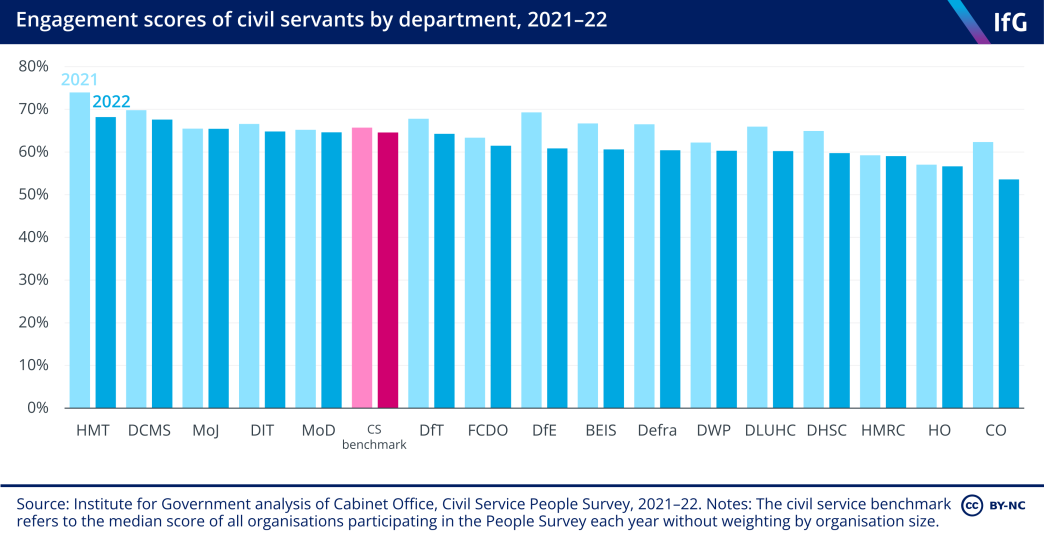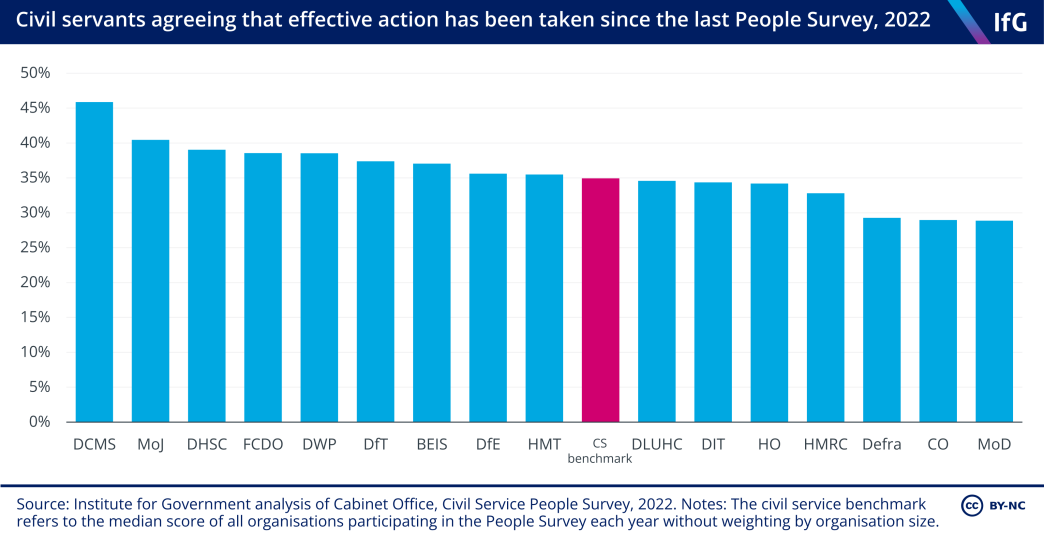Civil Service People Survey
What does the Civil Service People Survey tell us about civil servants' experience of working in government departments?

What is the Civil Service People Survey?
The Civil Service People Survey is an annual survey used to track civil servants’ “attitudes to, and experience of working in government departments”. 37 Civil Service, Civil Service people surveys, last updated 30 March 2023, retrieved 30 March 2023, www.gov.uk/government/collections/civil-service-people-surveys
It is one of the largest employee attitude surveys in the UK. In 2022, some 346,957 civil servants completed the survey, a response rate of 65%. Participation is not mandatory but strongly encouraged, and departments are held to account for low response rates.
The survey uses a census-based, rather than sample-based, format. This means that it is open for all civil servants to complete, rather than using a smaller, representative sample.
38
Public Administration and Constitutional Affairs Committee, ‘Written evidence from the Cabinet Office’, Civil Service People Survey Inquiry, August 2022, https://committees.parliament.uk/writtenevidence/110886/html/
The first survey was carried out in 2009. Prior to this, government organisations conducted separate surveys with different, mostly incomparable questions.
The UK is not the only country to carry out a civil service attitude survey: Australia,
39
Australian Public Service Commission, ‘The 2022 APS Employee Census Overall Results’, 23 November 2022, www.apsc.gov.au/initiatives-and-programs/workforce-information/2022-aps-employee-census/2022-overall-results
Canada,
40
Treasury Board of Canada Secretariat, ‘Public Service Employee Survey’, [no date], retrieved 28 March 2023, www.canada.ca/en/treasury-board-secretariat/services/innovation/public-service-employee-survey.html
Ireland
41
Department of Public Expenditure, NDP Delivery and Reform, ‘Civil Service Employee Engagement Surveys’, 24 February 2022, www.gov.ie/en/collection/5e7009-civil-service-employee-engagement-survey/
and New Zealand
42
Public Service Commission, ‘Te Taunaki Public Service Census 2021’, 7 December 2021, www.publicservice.govt.nz/research-and-data/te-taunaki-public-service-census-2021/
each conduct equivalent surveys. The Global Survey of Public Servants collates similar data from governments around the world.
43
GSPS Consortium, ‘About the Survey’, Global Survey of Public Servants, [no date], retrieved 30 March 2023, www.globalsurveyofpublicservants.org/
What does the survey measure?
The headline score of the survey is the employee ‘engagement index’, which reflects civil servants’ attitudes to their organisation, measuring pride, advocacy, attachment, inspiration and motivation.
Nine “theme scores” are used to track attitudes to issues such as pay and benefits, and organisational objectives and purpose. Other specific questions target civil servants’ views on management and leadership, learning and development opportunities, intentions to leave the civil service, and experiences of discrimination, bullying and harassment.
The survey also collects data on respondents’ working circumstances (including seniority and working location) and demographic profile, including age, ethnicity and socio-economic background. However the demographic data for 2022 has not yet been published.
What does the latest survey show?
In 2021, the civil service benchmark employee engagement decreased slightly for the first time since 2015 – and it continued to fall in 2022, to 65%.

The fall in morale has varied by department: engagement scores in the Cabinet Office (now the lowest-scoring department at 54%) and the Department for Education (61%) fell by 8 percentage points from 2021 to 2022.

There are a number of possible explanations for this decline in morale. In 2022, there were two changes of prime minister, while civil servants faced tension with government ministers over flexible working arrangements, proposed headcount reductions and, in particular, pay and conditions. Around three in ten (29%) civil servants were satisfied with their pay and benefits, a stark fall from 38% in 2021.

How have departments’ scores changed over time?
Over the longer term, most departments’ survey results tend to be relatively stable. For example, the Treasury has consistently had the highest engagement score (68% in 2022) of any core department since 2013, while the Home Office (57%) has been among the lowest since 2015.
Changes to departments’ work can significantly affect survey results, whether through a transformation programme, machinery of government changes, or a shock event like the pandemic. For example, the newly merged Foreign, Commonwealth and Development Office (FCDO) had an engagement score of 61% in 2022, lower than both the Foreign and Commonwealth Office (72%) and the Department for International Development (69%) in 2019, from which it was created in 2020.
The survey also gives civil servants the opportunity to express their views on their leadership, and how change in their department is managed. As with many of the metrics in the survey, there can be significant fluctuation here – while in 2020 a peak of 62% of officials in the Department of Health and Social Care (DHSC) were satisfied with their leadership, this fell to just 49% in 2022.

Inclusion and fair treatment is another important theme, which has improved for the civil service benchmark over the last decade, from 73% in 2010 to 81% in 2022. Some improvements have been particularly strong: despite having the lowest score for inclusion in 2012, DCMS has been among the best-performing departments for this theme since 2015. Conversely, the FCDO’s inclusion score (74% in 2022) is among the worst since 2020, whereas its predecessor department, the FCO, consistently scored above the civil service median.

What action is taken in response to the survey results?
Most action taken in response to the survey occurs at the departmental level. Accountability ultimately sits with permanent secretaries within each department and, within those departments, the senior managers of each area.
In 2022, around a third (33%) of civil servants were confident that, in their organisation, effective action had been taken on the results of the previous survey.

As the central co-ordinating department for the survey, the Cabinet Office promotes and shares best practice in response to survey results – it has previously published case studies of departments’ attempts to improve wellbeing scores.
44
Cabinet Office, Engagement and wellbeing: Civil Service success stories, 21 December 2016, www.gov.uk/government/collections/engagement-and-wellbeing-civil-service-success-stories
It also regularly engages with the five largest government departments (MoJ, DWP, HMRC, MoD and HO) to discuss the survey.
45
Public Administration and Constitutional Affairs Committee, ‘Written evidence from the Cabinet Office’, Civil Service People Survey Inquiry, August 2022, https://committees.parliament.uk/writtenevidence/110886/html/
In 2018, the civil service launched a review into bullying, harassment and misconduct arrangements following consistent survey results showing that 11–12% civil servants felt bullied or harassed at work.
46
Civil Service HR, ‘Review of Arrangements for Tackling Bullying, Harassment and Misconduct in the Civil Service’, 2018, www.gov.uk/government/publications/bullying-harassment-and-misconduct-review
Since 2020 however this proportion has remained at around 9%.

What issues are there with the survey?
The Public Administration and Constitutional Affairs Committee (PACAC) launched an inquiry into the Civil Service People Survey in July 2022, due to low participation rates in certain government departments and a concern from the PCS union, representing civil servants, about a lack of action taken in response to issues raised in the survey. 47 Public Administration and Constitutional Affairs Committee, ‘MPs seek evidence on effectiveness of Civil Service People Survey’, 13 July 2022, https://committees.parliament.uk/committee/327/public-administration-and-constitutional-affairs-committee/news/172042/mps-seek-evidence-on-effectiven…
The survey has also been criticised for over-emphasis on the engagement index, which does not factor in responses concerning pay or bullying, harassment and discrimination. 48 Dunton J, ‘MoJ staff urged to boycott 2021 Civil Service People Survey’, Civil Service World, 1 October 2021, www.civilserviceworld.com/professions/article/moj-staff-urged-to-boycott-2021-civil-service-people-survey
For further information or to ask a specific question about the People Survey, contact the authors.
- Topic
- Civil service
- Keywords
- Civil servants Civil service reform
- Publisher
- Institute for Government